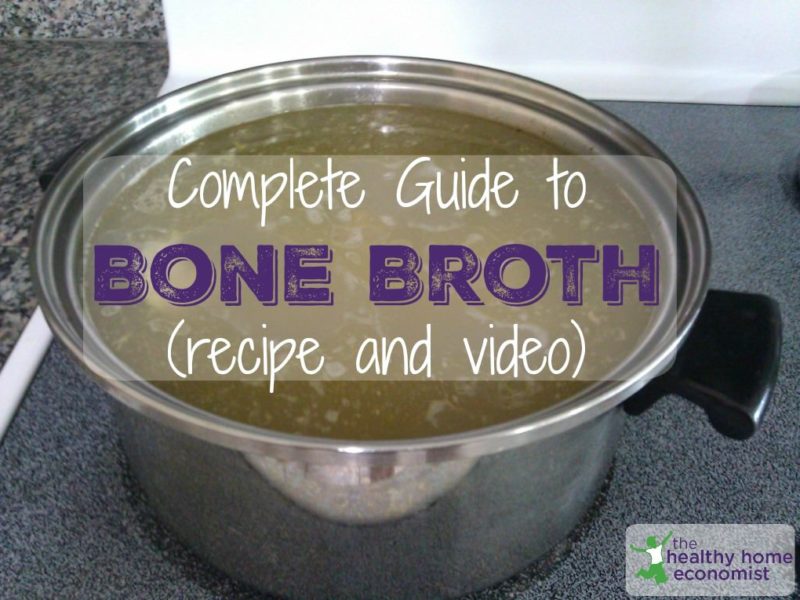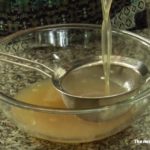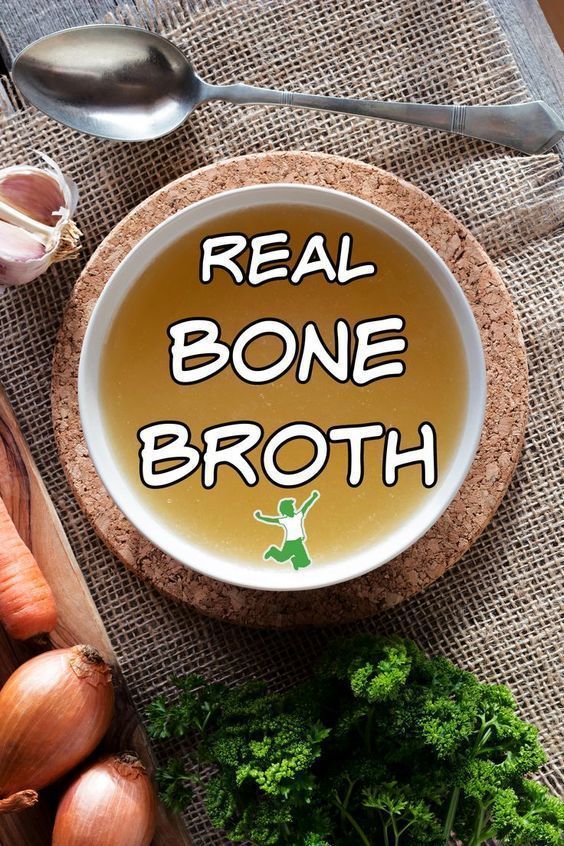Table of Contents[Hide][Show]

If you are like most modern households, you probably toss meat bones once the protein portion is used up. If this describes your kitchen routine, you might want to rethink that. Did you know that you make about a gallon of homemade, mineral-rich bone broth simply by simmering them in filtered water? Add a bit of vinegar and a few chopped veggies and you will add even more flavor and nutrition.
Making traditional bone broth should be a regular and hopefully weekly part of your kitchen routine. If you are spending your limited kitchen time making bread or other baked goods, then re-prioritize some of this time into making bone broth.
Dr. Francis Pottenger MD considered the stockpot the most important piece of equipment in the kitchen. Note that it wasn’t the grain grinder or the bread pans!
I have no doubt in my mind that the most important time I spend in the kitchen for my family is the time spent making bone broth and soups and other dishes using it.
This may seem a bit shocking at first, but homemade stock as a regular feature in your diet will improve your health much more than homemade bread will! Make sure the time you spend in the kitchen gets you the most bang for your buck health-wise.
Not all the time spent in the kitchen is created equal!
History of Bone Broth
Since before the dawn of human civilization, bone broth, or stock as it is commonly known, has played a pivotal role in human health.
Primitive cultures practiced grinding the bones of small animals with water to make a mineral-rich paste.
As human culture advanced, bones were cooked in water to make stock which was consumed on its own or used as a base for soups, sauces, and stews. In cultures that did not consume dairy products, broth including bone marrow was absolutely critical. It supplied plentiful calcium, magnesium, and potassium in the proper proportions to the diet.
In Asia, bone broth is traditionally consumed with every meal – even breakfast. During my travels in Japan in the late 1980s, fish broth was a regular feature on the breakfast table and was sometimes mixed with a bit of miso for additional flavor.
Bone broth is found in other traditional cuisines from around the world on nearly every inhabited continent including Africa, South America, North America, Europe, and Asia. Interestingly, a study of the Aboriginal peoples of Australia makes no mention of any special use or preparation of bones into pastes or broths.
Health Benefits
Properly prepared bone broths as practiced by traditional cuisines are extremely nutritious and beneficial for 3 key reasons. This includes bone and meat stocks:
- They supply plentiful and easily absorbed nutrients to the diet such as silicon, sulfur, and phosphorus as well as trace minerals. Calcium in broth is surprisingly not so plentiful according to research. Quality is important to avoid issues with lead.
- Stock supplies the broken down materials from cartilage and tendons like glucosamine and chondroitin sulfates which aid the healthy and pain-free maintenance of joints in the body.
- Bone broths supply natural, unadulterated gelatin to the diet which is a health boon to many tissues of the body including of course the cartilage, bones, and joints but also the skin, digestive tract, and muscles including the heart.
- Broth is highly anti-parasitic according to research published in a peer-reviewed journal.
Protein
The protein in bone broth comes from the gelatin. It is true that gelatin is not a substitute for meat as it is not a complete protein. It contains only the amino acids proline and glycine in large amounts and others like methionine, histidine, and tyrosine in very small amounts. The amino acid tryptophan is completely lacking in gelatin.
Despite containing only 2 amino acids in sufficient quantity, gelatin does indeed act as a remarkable protein sparer. This means that much less meat is needed to maintain health when gelatin in the diet is present.
Eating Broth Regularly Allows Less Meat in the Diet
In other words, “sparing” protein, means that the body is much less likely to use protein from its own muscles. This is what would happen during times of economic austerity or illness when rapid weight loss would potentially occur with little food consumed or available. Gelatin keeps the body in what researchers called “nitrogen balance” by permitting less complete proteins to be consumed with no loss of health observed.
This research was reported by Carl Voit in 1860. His experiments sparked further experimentation which revealed that the amount of meat in the diet could be reduced by more than half through the addition of gelatin with good health maintained.
From a practical perspective, including plenty of broth in the family’s menu makes a tight food budget much more manageable as meat is typically one of the most expensive items on the shopping list.
Gelatin Improves Protein Digestion
In addition to its protein-sparing abilities, gelatin also enhances digestion through improved utilization and absorption of other proteins in the diet such as those from beans, dairy, wheat, oats, and barley though not of corn as shown in research from the early 1900s.
The improved digestive effect of gelatin was shown by Carl Voit to specifically improve the flow of digestive juices and normalization of the production of hydrochloric acid in the stomach. The amino acid glycine which is abundant in gelatin is responsible for the encouragement of this flow of gastric juices.
Besides normalizing the gastric process, gelatin contains hydrophilic colloids which means that instead of repelling gastric juices like other cooked foods, gelatin attracts them in a manner similar to raw food.
Dr. Francis Pottenger MD found that the simple addition of one-half ounce to one ounce of gelatin to a fully cooked meal of potatoes, meat and vegetables would allow the digestive process to proceed smoothly so that all the components of the meal are acted upon by the digestive process with equal effect.
Detoxification
In addition to the remarkable bone broth nutrition, probably the most exciting thing about bone stock is its role in detoxification.
This is due to the large amounts of the amino acid glycine which assists the liver with its housecleaning duties. The simplest of all the amino acids, glycine can be produced by the body and is therefore not considered essential, although the ease of the body in manufacturing glycine as needed is probably highly contingent upon whether a person is in radiantly good health!
The ability of the liver to do its job sufficiently is limited by the amount of glycine that is available so it makes sense to provide the body with all that it could possibly need!
Hint! Cooking chicken feet along with the rest of the chicken meat/bones in the simmering stockpot will add a lot of extra gelatin for a major boost in detoxification properties.
Broth Encourages a Healthy Liver
Dr. Reuben Ottenberg in 1935 suggested in the Journal of the American Medical Association that patients with jaundice or other liver problems be administered 5-10 grams of gelatin per day as food or via a powdered gelatin supplement to supply additional glycine to the diet in order to encourage normalized hepatic function.
Given the toxicity of our world today and the high level of chemicals in our air, water, and food, large amounts of glycine in the diet has become one way to assist the body with the nearly constant detoxification that is required to maintain health.
Homemade Bone Broth
My family of 5 can easily go through 2 gallons of homemade stock in a single week. My freezer is usually loaded to the brim with various kinds of broth. Common types of bone broth that I frequently make include fish, beef, and chicken. I also occasionally make venison, buffalo, lamb, turkey, duck, or even rabbit and goose! Varying the types of broth add a nutritional as well as a nice flavor variety to dishes.
Tip: Make sure you label your broth containers as they pretty much all look the same after freezing!
Should you use plastic or glass for broth storage? It’s really up to you. If you use plastic, it is safe as long as it is a non-leeching type and you pour the broth in at room temperature. Never pour boiling hot broth into plastic as ALL plastic leeches when exposed to heat.
If you use glass, leave a couple of inches at the top for expansion and use freezer-safe jars to prevent accidents.
Traditional vs Commercial Brands
Is buying broth a good idea when homemade isn’t an option? In my view, it is best not to buy bone broth, especially if embarking on a broth fast to lose weight. The reason is two-fold.
First, commercial bone broths are typically packaged in toxic plastic or aseptic cartons lined with plastic. If shelf-stable, the bone broth is boiling hot when poured into these containers. Even if the company claims that the plastic is the non-leeching kind, it will still leech toxins when coming into contact with a high-temperature liquid.
Secondly, commercial bone broth is watered down. All but a single brand I’ve tested fails to gel in the refrigerator like homemade bone broth. If you’re interested, this is the brand that gels beautifully if you prefer to buy your broth. It’s expensive though! If you are looking for the most nutritious and beneficial bone broth that is economical too, however, make it yourself.
Types of Bones to Use
To get the most gelatinous and flavorful broth, it is extremely important to use get the right mix of bones. Make sure you use one of the following methods else the broth won’t gel.
- 1 whole, free-range layer hen with neck and wings cut up
- 3-4 pounds of boney chicken parts which includes a combo of necks, backs, and wings
- The picked carcass of 2 meat chickens.
- For beef broth, use about 7 lbs bones total. The best ratio is 4 pounds of boney bones and 3 pounds of meaty bones (including marrow).
Note that you can mix bones if you like. I frequently mix chicken and turkey bones, for example, to produce the right mix for a pot of broth.
Types of Bone Broth and Stock
The instructions in the recipe outline a basic bone broth recipe using any type of poultry. This is the type most people start out with.
Once you get comfortable, you can branch out and try other recipes. If you prefer clear or clarified stock, the linked article outlines several methods for easy removal of fat to achieve this.
- Turkey broth
- Fish broth
- Shrimp stock
- Crawfish stock
- Lobster broth
- Pork broth
- Rabbit broth
- Goose stock
- Duck broth
- Bonito broth
This detailed article on the healthiest and best type of broth will help you decide which types you may want to incorporate into your kitchen routine on a regular basis.
Organic Bone Broth?
Compared to conventional, organic bone broth will always be the best tasting. It will also be the most nutritious, producing little to no scum (off-flavors and toxins) that requires skimming when the broth is brought to a boil. Hence, if your food budget can include organically sourced bones, it is worth the extra cost!
However, any bone broth is better than none at all. So, if you cannot afford organic bones, use conventional. Just be prepared to spend a few minutes with each batch to carefully remove the foam as you are making it.
Can You Use Bones to Make Broth More than Once?
You can definitely use bones more than once to make multiple pots of bone broth. Remouillage is the name of this frugal French cooking method. It is guaranteed to save you a lot of money over time! Typically, I use poultry bones twice. Harder bones such as beef, bison or pork I use up to three or four times before throwing them out. I only use fish bones once, however, as they tend to disintegrate after one pot of bone broth is made.
Recommended Seasoning
If you don’t have time to add veggies and/or meat to transform bone broth into soup, you can just add seasoning and sip it as is! Adding sea salt, a crushed garlic clove and some kelp flakes is quick and tasty. I outline other suggestions for perfectly seasoned broth in this linked article.

Traditional Homemade Bone Broth Recipe
Homemade bone broth recipe using the optimal proportion of bones and meat to achieve a stock that is loaded with gelatin for maximum health benefits and gut healing. Bonus, you may mix different types of bones if necessary.
Ingredients
- 1 whole chicken preferably pastured or free range
- filtered water enough to cover
- 1/4 cup apple cider vinegar preferably organic packed in glass bottles
- 2-3 carrots preferably organic
- 2-3 celery stalks preferably organic
- 1 large onion preferably organic
- 1 bunch fresh parsley preferably organic
- 2-4 chicken feet optional (adds extra gelatin)
Instructions
-
Place the whole chicken or chicken bones in a large pot and cover with filtered water.
-
Add vinegar and chopped vegetables except for the parsley. Let stand for 30 minutes to allow vinegar to being to pull minerals from the bones and veggies.

-
Add lid and place on the stovetop burner on high.
-
Bring to a boil, remove lid, and skim off foam with a large, slotted wooden or stainless steel spoon (not a plastic one!). The foam are off flavors. This step will significantly improve the flavor of the bone broth.

-
Reduce heat, replace lid and simmer for 6-24 hours.
-
10 minutes before bone broth is done add parsley. Replace lid and simmer for the final 10 minutes. This will add additional minerals to the bone broth.

-
Turn off heat, remove lid and strain stock. Soft bones may be given to your pet or discarded. The vegetables make great compost. Meat can be used for chicken salad, sandwiches or Mexican dishes.

-
Place strained bone broth in containers in the fridge once cooled to room temperature.
-
Skim fat off the top of refrigerated bone broth and store in separate containers for use in cooking. This process is actually even easier if you freeze the broth first.

-
Freeze bone broth that you will not use within 5 days.

-
Turkey, goose, and duck stock are made basically with the exact same process as above.
Recipe Video
Recipe Notes
If you make chicken stock with leftover bones, browning them in the oven first will add extra flavor to your broth.
If you bone broth tastes bland, this article on seasoning stock is helpful.
I would recommend not using white vinegar for making broth as it is usually derived from GMO corn.
How to Make Chicken and Beef Bone Broth
It’s a good idea to fully embrace stock making in your home if you haven’t already. Throw out those soup cans and stock tetra-packs which are nothing but water, MSG, and BPA anyway. Even if organic, there is no comparison with the nutrition of homemade stocks and soups that improve health tremendously.
The video below demonstrates the written chicken broth recipe above. This recipe is the same for other types of poultry including duck, turkey, and goose. You can also make it from game birds such as quail. The tutorial also covers homemade beef broth. Use the beef broth recipe to make venison, lamb, bison or pork broth.
FAQ
5 Reasons Why Your Stock Won’t Gel
Stock versus Broth
Glass vs Plastic for Storing Stock
Lead in Broth Made at Home
Calcium in Homemade Stock
MSG in Broth Made from Bones?
The Perfect Simmer on Your Broth









What about the stock in the pan after I have roasted a chicken?(I use this to make rice more flavorful) or even a meat like eye round and I’ll use this to make gravy but sometimes there is a lot of juice left in the pan even after I make gravy, can these be used in the stock pot as flavor enhancers as well or can they just be stored seperately? which is what I sometimes do and use them for other meals during the week.
Please dont think that this is a stupid question. In the event you don’t have grass fed meats to do the stocks (either there are no local places offering them or its just too expensive) is it still beneficial to make stocks if you don’t know the history of the meats origin? Thank you!
Yes, make the stock. That is the most important thing. Get the best meat/bones you can afford.
Thanks Megan for asking this. I was wondering it myself. We are low on meat/bones from our 1/2 grass-fed cow and low in funds, so I may need to head to the local butcher in the coming weeks.
I have been making beef stock without roasting. Must the bones be roasted first or is that for increased flavor or rendering the fat?
Hi
If u place the stock in the flask, how do you thaw them for use?
Is it ok to thaw the stock, pour off what you need then freeze it again repeatedly for each use?
Are there alternative methods for storing if my freezer does not have a lot of storage space for flasks?
Thanks
Is it safe to eat the cooked bones from the stock? I don’t want to cause or aggravate constipation but I love the taste of the soft melt-in-your-mouth bones with marrow in them (like chicken leg bones). Does anyone know? Thanks!
I would be cautious about that … I’m very concerned choking would be quite a risk.
My mom used to eat the bones because she cooked them so long that they weren’t hard at all and would just crumble so choking shouldn’t be a problem at that point but I wonder also is there a problem eating the bones esp if it’s not pastured chickens.
Hi Sarah!
I was wondering if you’d ever heard of or tried adding eggshells to your stock while it is making? I’ve heard of it before and think it would be a good way to use some of the farm-fresh eggshells that I have. What do you think?
Also, do you make stock with the lid fully on, partly on, or off? I tried making it with the lid off and the smell in the house was way TOO powerful.
My Mother in Law soaks crushed eggshells in water and some vinegar in a jar … not sure the proportions are .. then uses the water as a mineral loaded tincture. I will try to find out about that. I’ve never used eggshells in stock.
My chicken stock does not seem to be gelatinous. I transferred it to 1/2 gallon glass jars in the fridge and it just looks like liquid. What am I doing wrong? I cooked a chicken for 8 hours in a 16 qt stock pot, then took the meat off and put the bones back in a crock pot completely covered with water for another 24 hours. We are on day 4 of intro GAPS so I’m concerned that our efforts are being wasted if my stock isn’t nutritious enough. I’ve also been using the liquid from the stock pot after the chicken is done cooking. In the E-book on how to eat for 30 days that I bought that is how she recommends to make the stock and doesn’t even mention bones. I’m so confused!
What kind of chicken are you using? If it’s not a high quality chicken, it may be dificult to exract a good ammount of gelatin. It may be possible that you diluted it a bit too much. How much water/stock did you end up with, and how big was the chicken?
It was a 4.5 pound or so chicken. I used the 16qt stock pot and filled to cover the chicken. Should I use my 12 qt instead? The quality of the chicken is not ideal, but not the worst either. My confusion is also this – my mother in law has used the same chicken sources and hers is jello-like. As far as I can tell we aren’t doing anything different from each other?
I love making stock and soup. This is SOOOOO awesome 😉
I also do add the vinegar… the flavor is extended, in addition to health benefits.
How are you getting that much stock. My turkey bones gave me less than two quarts. Should I be adding way more water with just one carcass?
Thank you! 🙂
A bigger turkey makes more stock. You should use enough filtered water to cover the bones completely, which in my stockpot is about 6-8 quarts of water.
Do the bones need to be covered with water the entire time you are simmering? I read if you have a storage space problem (as I do) then boiling the stock down is a good idea. That’s what I did. I boiled it down, then simmered for 24 hours.
No, you keep the bones covered the entire time its simmering. AFter its done and you remove the bones, you can boil it down.